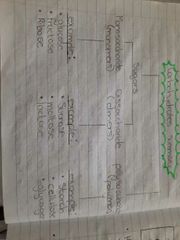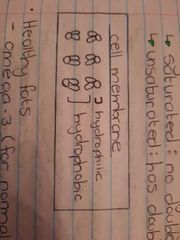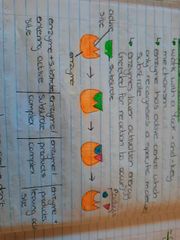![]()
![]()
![]()
Use LEFT and RIGHT arrow keys to navigate between flashcards;
Use UP and DOWN arrow keys to flip the card;
H to show hint;
A reads text to speech;
107 Cards in this Set
- Front
- Back
|
Name the 7 characteristics of life. |
1. Organims grow and develop. 2. Organisms adapt to their environment. 3. Organisms reproduce 4. Organisms regulate own metabolic activities 5. Organisms take in energy. 6. Organisms react to stimuli. 7. Organisms consist on cells. |
|
|
Name the biological organisation in order. |
1. Atoms 2. Molecules 3. Organelles 4. Cells 5. Tissue 6. Organ 7. Organ system 8. Organism 9. Ecosystem 10. Biosphere |
|
|
Whats the difference between organic and inorganic compounds? |
Organic 1. Have a living origin. 2. Large number of carbon atoms ( H,O,N,P). 3. Large and complex molecules.
Inorganic 1. Don't have living origin. 2. Don't contain carbon except for CO², CO, CN. 3. Simple molecules. |
|
|
Name 5 important elements need by living things. |
1. Carbon 2. Oxygen 3. Hydrogen 4. Sodium 5. Iron |
|
|
Name 3 essential elements for inorganic compounds. |
1. Water. 2. Minerals. 3. Acids, bases & salts. |
|
|
Name 3 facts about water. |
1. 70% human body. 2. Solvent & medium in which most biological reactions take place. 3. Habitat for many organisms. |
|
|
What is it called when water molecules form hydrogen bonds ? |
Strong intermolecular forces. |
|
|
What are strong intermolecule forces responsible for ? |
Cohesion and adhesion forces. |
|
|
Whats the difference between adhesion and cohesion forces ? |
Cohesion forces - cling to same molecules. Adhesion forces - cling to other molecules. |
|
|
What are substances that are water loving and water soluble? |
Hydrophilic |
|
|
What are substances that are water scared and do no dissolve in water ? |
Hydrophobic |
|
|
Whats the difference between hydrophilic and hydrophobic ? |
Hydrophilic - water loving and water soluble. Hydrophobic - scared of the water and don't dissolve in water. |
|
|
Why are minerals important ? |
Important for functioning of cells, metabolic processes and bodys general well-being. |
|
|
What are the minerals called that we need large quantities daily. |
Macronutrients. |
|
|
What are the minerals called that we only need small quantities of? |
Micronutrients. |
|
|
Whats the difference between micronutrients and macronutrients ? |
Macronutrients- minerals needed in large quantities daily. Micronutrients- minerals that you only need small quantities daily. |
|
|
What pH is gastric juice and HCL in the stomach ? |
Acidic |
|
|
What is the pH of the small intestine? |
Alkaline |
|
|
pH scale ? |
Indicates degree of acidity/alkalinity. |
|
|
Blood has a constant pH of what ? |
+- 7,4 |
|
|
Too acidic ? |
Coma/ death |
|
|
Too alkaline? |
Nerve problems. |
|
|
What do organisms have ? |
Buffers |
|
|
What is buffers ? |
Substance/s counteracting pH changes. |
|
|
How do electrolytes form ? |
Form when salt dissolves in water and conduct electric currents. |
|
|
What are electrolytes important for ? |
In nerve impulses and muscle functioning. |
|
|
Organic compounds ? |
Organic molecules are usually polymers consisting of smaller building blocks , the monomers. |
|
|
Name 3 organic compounds. |
1. Carbohydrates. 2. Fats and oils (Lipids). 3. Proteins. |
|
|
Give 3 examples of carbohydrates. |
1. Sugar ( source if energy for cells ) 2. Starch ( source of energy for cells ) 3. Cellulose (found in plant cell walls ) |
|
|
What is the purpose for cellulose in plant cell walls ? |
Strength, shape and protection. |
|
|
What is the building blocks of carbohydrates? |
Monosaccharides |
|
|
What is monosaccharides ? |
Simple sugars. |
|
|
Carbohydrates are made up of what elements ? |
C, H, O |
|
|
Carbohydrates are divided into 3 groups, name them. |
Monosaccharides (one saccharide) Disaccharides (two monosaccharides) Polysaccharides (many monosaccharides) |
|
|
What is the ratio of H atoms to O atoms ? |
2:1 meaning when is there is 20 H atoms there will be 10 O atoms |
|
|
Name the 3 types of monosaccharides. |
1. Glucose 2. Fructose 3. Galactose |
|
|
What do monosaccharides look like ? |
Single ring structures. |
|
|
Glucose ? |
- Stored as starch in plants and as glycogen in animals. - energy source for living organisms. |
|
|
Where is fructose found ? |
Found in fruit and honey and is sweeter than glucose. |
|
|
Galactose ? |
Part of disaccharide lactose (milk sugar). |
|
|
Disaccharides? |
2 monosaccharides |
|
|
Give 3 types of Disaccharides. |
1. Glucose + glucose = MALTOSE (malt sugar) 2. Glucose + fructose = SUCROSE( cone sugar ) 3. Glucose + galactose = LACTOSE ( milk sugar ) |
|
|
What are Polysaccharides? |
Macromolecules with 1000's of inter connected monomers. |
|
|
What are the 3 types of polysaccharides ? |
1. Starch 2. Glycogen 3. Cellulose |
|
|
Starch ? |
Usual form of carbohydrates. |
|
|
Give two types of starch. |
1. Amylose 2. Amylopectin |
|
|
Glycogen ? |
- Form of reserve carbohydrates stored in animal cells. - Insoluble in water. |
|
|
Where is glycogen stored? |
Stored in muscle and liver cells. |
|
|
Cellulose ? |
- part of plant cells. - insoluble in water. |
|
|
What is cellulose important for ? |
Important in diets as roughage for peritalsis. |
|
|
What can digest cellulose? |
Only micro-organisms. |
|
|
Chitin? |
In exoskeleton of insects and fungi cell walls.( structure related to cellulose) |
|
|
Draw the carbohydrates summary chart. |

|
|
|
Whats another word for Fats and oils ? |
Lipids |
|
|
What elements does lipids contain ? |
C, H, O |
|
|
Give 3 functions of lipids. |
1. Insulation. 2. Energy storage. 3. Important component of cell membranes. |
|
|
How is lipids formed ? |
Formed from 1 glycerol (alcohol) + 3 fatty acids. |
|
|
What are the building blocks of lipids ? |
Glycerol and fatty acids. |
|
|
Lipids are ? |
Insoluble in water meaning they hydrophobic. |
|
|
What are the 2 different fats ? |
Saturated and unsaturated fats. |
|
|
Difference between saturated and unsaturated fats. |
Saturated - no double bonds (solid at room temp.) Unsaturated - has double bonds (liquid at room temp.) |
|

What is this called and lable |

|
|
|
Name 4 healthy fats and there reasons. |
1. Omega-3 ( for normal metabolic reactions ) 2. Vitamins A, D, E, K ( only soluble in fat ) 3. Phospholipids ( form cell membrane ) 4. Cholesterol ( important for cell membranes ) |
|
|
What can too much cholesterol cause ? |
Plaque in blood vessals. |
|
|
Unsaturated fats ? |
Liquid at room temperature and is mainly in plants like sunflower oil and olive oil. |
|
|
Saturated fats ? |
Solid at room temperature and is mainly in animal fats. |
|
|
Name the two types of carbon atoms. |
Pentose sugars - ribose - deoxyribose
Hexose sugars - glucose - fructose - Galactose |
|
|
What elements does proteins contain ? |
C, H ,O, S , N and FE |
|
|
What is proteins made from? |
Amino acids ( monomers ) |
|
|
What are proteins involved in and name 4. |
Cellular functions - structure - cell membrane - protection - growth |
|
|
All enzymes = ? And give 3 things that make them the same. |
Proteins - need specific temperature + pH levels. - heat = denature , cold = inactive. - best temp in human body = 37°C |
|
|
Amino acids bind by ? |
Peptide bonds |
|
|
2 amino acids = 3 amino acids = 3+ amino acids = 50+ amino acids = |
Bipeptide Tripeptide Polypeptide Protein |
|
|
Bipeptide = Tripeptide = Polypeptide = Protein = |
2 amino acids 3 amino acids 3+ minor acids 50+ amino acids |
|
|
What are the two things that can produce there own amino acids? |
Bacteria and plants |
|
|
What can bacteria and plants produce? |
There own amino acids |
|
|
What is the sequence called in which amino acids occur ? |
Primary structure |
|
|
Primary structure? |
The sequence in which amino acids occur |
|
|
Proteins are sensitive to temperature and pH explain what happens at high and low temps. |
High temps - denatured protein (destroy protein). Low temps - inactivate the protein. |
|
|
What is a protein ? |
A protein is a polymer with amino acids as monomers. |
|
|
How are polymers formed ? |
By condensation synthesis which is when amino acids join together + H²O molecule is released. |
|
|
How are proteins broken down ? |
By hydrolysis ( adding water) |
|
|
Secondary and tertiary structures? |
Shape of polypeptide |
|
|
What are the 2 reactions controlled by enzymes ? |
Proteins are formed when animo acids are joined together + H²O molecule is released and proteins are broken down by hydrolysis. |
|
|
What are enzymes ? |
Enzymes are proteins that act as a biological catalyst.
|
|
|
What are biological catalysts? |
- speed up biochemical reactions without taking part or undergoing any changed. |
|
|
What are the toxins that permantly inhibit enzymes? |
Lead, mercury and cyanide |
|
|
Enzyme activity? |
Work with a lock-and-key mechanism. |
|
|
Draw the lock-and-key model. |

|
|
|
In the enzyme activity the substance formed during the reaction is called the ? |
Product |
|
|
Reactions in enzyme activity can be what ? |
Anabolic : building up Catabolic : breaking down |
|
|
Non protein part ? |
Prosthetic group |
|
|
Co-factors = ? Co-enzymes = ? |
Co-factors = inorganic prosthetic group with many minerals Co-enzymes = organic prosthetic group with many vitamins |
|
|
Nucleic acids ? |
Transfer genetic information and determine the types of protein produced by a cell. |
|
|
Give the two types of nucleic acids . |
Ribosnucleic acid Deoxyribonucleic acid |
|
|
What are enzymes a good example of that we use in out daily Iives? |
Biotechnology. |
|
|
Give 3 examples of biotechnology that is used daily in out households. |
1. Detergents 2. Food and beverages 3. Leather |
|
|
Vitamins ? |
Organic compounds essential for the metabolic reactions. |
|
|
What are the 2 groups of vitamins ? |
Fat soluble = (A,D,E,K) Water soluble = (B+C) |
|
|
Give the source, function and effects of deficiency for vitamin A. |
Source = milk and green/yellow vegetables. Function = healthy skin EOD = night blindness |
|
|
Give the source, function and effects of deficiency for vitamin B¹. |
Source = liver , meat and leafy vegetables. Function =co-enzyme needed for carbohydrates. EOD = beri-beri and weak cardiac muscles. |
|
|
Give the source, function and effects of deficiency for vitamin B³. |
Source =liver , meat and leafy vegetables. Function = Co-enzyme in amino acid and metabolism. EOD = reactions in cells are blocked. Pellagra. |
|
|
Give the source, function and effects of deficiency for vitamin C. |
Source = strawberries and tomatoes. Function = maintains connective tissue and health of blood vessels. EOD = scurvy |
|
|
Give the source, function and effects of deficiency for vitamin D. |
Source = egg yolk and milk. Function = promotes strong muscle and teeth. EOD = rickets |
|
|
Give the source, function and effects of deficiency for vitamin E. |
Source = nuts and leafy vegetables. Function = protection against aging. EOD = damage to nervous system. |
|
|
Give the source, function and effects of deficiency for vitamin K. |
Source = leafy vegetables. Function = synthesis of proteins for clotting of blood. EOD = clotting of blood. |
|
|
RDA = ? FDA = ? |
RDA = recommended daily allowance FDA = food+drug administration. |

